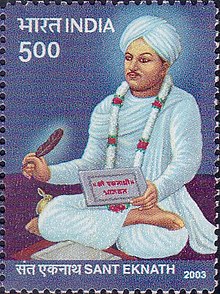Eknath
Eknath | |
|---|---|
 Eknath on a 2003 stamp of India | |
| Personal | |
| Born | 1533 |
| Died | 1599(aged 65–66) |
| Religion | Hinduism |
| Parents |
|
| Organization | |
| Philosophy | Advaita,Varkari |
| Religious career | |
| Literary works | Eknathi Bhagavata,Bhavarth Ramayan,Rukmini Swayamwar Hastamalak,Shukashtak,Swatma-Sukha,Ananda-Lahari,Chiranjeewa-Pad,Geeta-SaarandPrahlad-Vijaya |
| Honors | Sant(Saint) |
Eknath(IAST:Eka-nātha,Marathipronunciation:[eknath]) (1533–1599),[1]was an IndianHindusaint, philosopher and poet. He was a devotee of the Hindu deityVitthaland is a major figure of theWarkarimovement. Eknath is often viewed as a spiritual successor to the prominent Marathi saintsDnyaneshwarandNamdev.
Biography[edit]
Precise details of his life remain obscure. It is generally believed that Eknath lived during the latter three-quarters of the 16th-century. He was born into aDeshastha Rigvedi Brahminfamily ofVishwamitragotra to Suryanarayan and Rukmini Bai at Paithan, present-day Maharashtra and was a follower of the Ashvalayana Sutra. His father probably held the title ofKulkarniand kept financial accounts. Their family deity isEkviraDevi (or Renuka).[1]
His parents died while Eknath was young. He was then raised by his grandfather, Chakrapani. His great-grandfatherBhanudaswas another revered saint of theWarkarisect.[2][3]Eknath was a disciple ofJanardan Swami[4]who was a devotee of the Hindu deityDattatreya.He was against caste distinctions and spread the message that there was no distinction in God’s eyes between Brahmin and outcaste or between Hindu and Muslim.
Eknath'ssamadhishrine is located at Paithan near theGodavaririver. Celebrations commemorating Eknath are held every year around the month of March at Paithan.[5]
Literary contribution[edit]
Eknath was a creative person, who utilized his literary skills to compose religious work invernacularMarathi language,promoting local devotional religious practice, and opposing the suppressive caste-system propagated by the eliteBrahmins.
Eknath's writings include a variation of the Hindu religious textBhagavata Purana,known asEknathi Bhagavata.[6]He also wrote a variation of the Hindu epicRamayana,known asBhavarth Ramayan.He also composedRukmini SwayamwarHastamalak,a literary piece consisting of 764owee(poetic metre) and based on aSanskrithymn of the same name. He has also tried to shift the emphasis of Marathi literature from spiritual to narrative composition and introduced a new form of Marathi religious song called Bharood.
His other literary works includeShukashtak(447owee),https://shikshaved.com/category/marathi-essay/-Sukha(510owee),Ananda-Lahari(154owee),Chiranjeewa-Pad(42owee),Geeta-SaarandPrahlad-Vijaya.He introduced a new form of devotional melodies calledBharoodand wrote nearly 300 of them.[6]
See also[edit]
References[edit]
Citations
- ^abGanesh Vasudeo Tagare (1994).Eknath.Sahitya Akademi. p. 4.ISBN9788172014568.
EKNATH: A BIOGRAPHICAL SKETCH* (A. D. 1533–1599). A reference to the Marathi Vangmaya Kosh (A biographical dictionary of Marathi writers) shows that there were three authors called "Eknath" and seven authors who used the mudrika (Pen-name) "Eka-Janardan" used by our author Eknath. Eknath was a Rigvedi Deshastha Brahmin, a follower of the Ashvalayana Sutra. His Gotra was Vishvamitra. His family deity was Ekaveera Devi (or Renuka). His family lived at Paithan,...
- ^Novetzke (2013),pp. 141–142
- ^Schomer & McLeo (1987),p. 94
- ^"Coming Soon Page".Archived fromthe originalon 7 July 2020.Retrieved7 July2020.
- ^George Michell (1 May 2013).Southern India: A Guide to Monuments Sites & Museums.Roli Books Private Limited. p. 115.ISBN978-81-7436-903-1.
- ^abKeune, Jon Milton (2011).Eknāth Remembered and Reformed: Bhakti, Brahmans, and Untouchables in Marathi Historiography.New York, NY, USA: Columbia University press. p. 32.Retrieved9 March2016.
Bibliography
- Novetzke, Christian Lee (2013),Religion and Public Memory: A Cultural History of Saint Namdev in India,Columbia University Press,ISBN9780231512565
- Schomer, Karine; McLeo, W. H. (1987),The Sants: Studies in a Devotional Tradition of India,Motilal Banarsidass,ISBN9788120802773
External links[edit]
- Eknath - A Translation from Bhaktalilamrita by Justin E. Abbott (1927)at archive.org
- Shri Eknathi Bhagwat (Marathi)at archive.org
